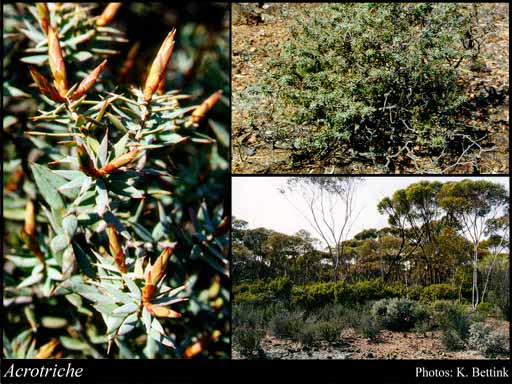- Reference
- Prodr. 547 (1810)
- Name Status
- Current

Scientific Description
Family Epacridaceae.
Habit and leaf form. Low shrubs; evergreen; leptocaul, or pachycaul. Helophytic to xerophytic. Leaves small; alternate; spiral, or four-ranked; ‘herbaceous’, or leathery (? rigid); imbricate, or not imbricate; shortly petiolate; non-sheathing; blunt or pungent; simple. Leaf blades entire; flat, or rolled; palmately veined; cross-venulate, or without cross-venules. Leaves without stipules. Leaf blade margins flat, or revolute. Stem anatomy. Nodes unilacunar. Secondary thickening developing from a conventional cambial ring.
Reproductive type, pollination. Fertile flowers hermaphrodite. Unisexual flowers absent. Plants hermaphrodite. Entomophilous, or ornithophilous. Pollination mechanism conspicuously specialized (via passive presentation involving corolla hairs, in Acrotriche serrulata), or unspecialized.
Inflorescence and flower features. Flowers aggregated in ‘inflorescences’; in spikes, or in fascicles (in clusters). Inflorescences axillary, or cauliflorous (below the leaves); sessile or shortly pedunculate. Flowers bracteate; bi- bracteolate; small; fragrant, or odourless; regular; (4–)5 merous; cyclic; tetracyclic. Free hypanthium absent. Hypogynous disk present (enveloping the proximal half of the ovary); intrastaminal; annular. Perianth with distinct calyx and corolla; 10; 2 -whorled; isomerous. Calyx 5; 1 -whorled; polysepalous; imbricate; usually exceeded by the corolla; regular; persistent. Corolla 5; 1 -whorled; gamopetalous; lobed (lobes spreading); valvate; tubular; regular; glabrous abaxially; hairy adaxially (with a tuft of hairs near the lobe tip; throat closed by hairs which arise direct from epidermal cells on a scale or cushion); green; persistent, or deciduous. Androecium 5. Androecial members adnate (to the corolla); all equal; free of one another; 1 -whorled. Androecium exclusively of fertile stamens. Stamens 5. Staminal insertion in the throat of the corolla tube. Stamens becoming exserted, or remaining included (at first enclosed but later pendulous on the outside between the corolla lobes); isomerous with the perianth; oppositisepalous; all alternating with the corolla members. Filaments glabrous; short or long and reflexed. Anthers dorsifixed; becoming inverted during development, their morphological bases ostensibly apical in the mature stamens; non-versatile; dehiscing via longitudinal slits (usually by a single median slit); finally introrse (inverting during development); unilocular, or bilocular; bisporangiate; unappendaged. Pollen shed in aggregates; without viscin strands; in tetrads. Gynoecium 2–10 carpelled. The pistil 2–10 celled. Gynoecium syncarpous; eu-syncarpous; superior. Ovary plurilocular; 2–10 locular. Gynoecium stylate. Styles 1; attenuate from the ovary; apical. Stigmas 1; truncate, or clavate, or capitate. Placentation apical. Ovules 1 per locule; pendulous; non-arillate; anatropous.
Fruit and seed features. Fruit fleshy; indehiscent; a drupe. The drupes with one stone (the pyrene breaking into unilocular segments under pressure). Seeds endospermic. Endosperm oily. Seeds wingless. Embryo well differentiated. Cotyledons 2. Embryo straight. Seedling. Germination phanerocotylar.
Physiology, biochemistry. Aluminium accumulation not found. Photosynthetic pathway: C3.
Additional characters Prophylls few.